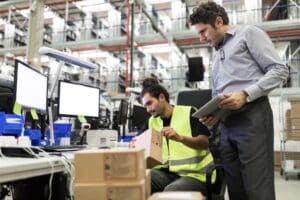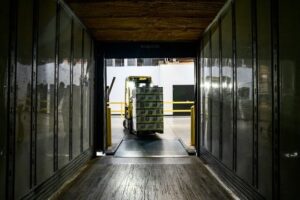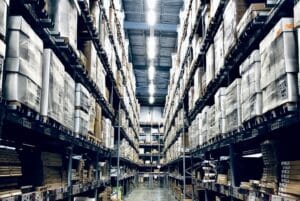The context and challenges of trolley 4.0
Logistics
4.0 solutions
Supply Chain
October 10, 2024
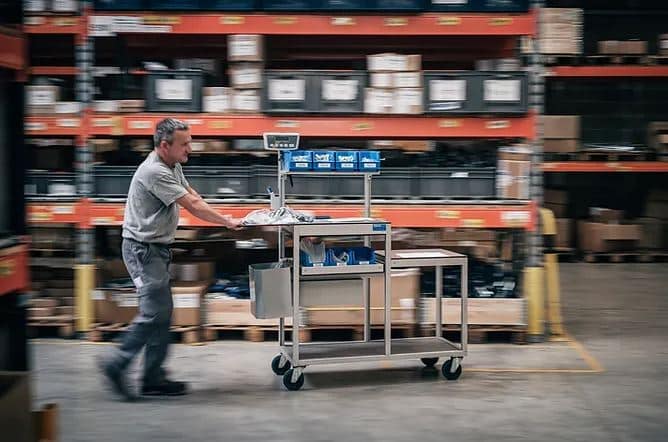
In the world of logistics, the trolley is a warehouse basic . We find it in storage, in picking replenishment or even in order preparation. Today it is an essential element for moving and identifying merchandise.
Following technological developments over time, the trolley that we all know has gradually transformed to become connected in order to adapt to the market.
What is a 4.0 trolley?
A 4.0 trolley is a connected trolley . This means that it embeds a certain number of technologies with the ability to communicate.
Among these technologies, we can find:
- The Panel PC equipped with a touch screen,
- Put to Light solutions for depositing items,
- Cameras, allowing for example to film or take a photo each time items are placed in order to create a memory,
- Weight control.
Added to these examples are other technologies such as RFID, as well as all kinds of automation that need to be controlled. For example, it is entirely possible to provide instant access to a hatch or a package using a connector.
What is the link with a WMS?
The cart serves productivity. From a logical point of view, the performance of a picker in the act of order preparation depends on the number of samples that he will manage to take on his route. The use of a WMS allows the operator to optimize his route and reduce the distance between each sample . This reduction will therefore lead to time savings and ultimately an increase in productivity.
How ? The WMS software intervenes here as a creator of missions which will then be assigned to the preparer . In order to constitute these missions, the WMS first analyzes the data at its disposal (the orders concerned by a cart preparation, the processing order, the urgency, the date, etc.) which it will cross-reference. with the available resources (the authorization of the preparers, the capacity of the cart, etc.).
The WMS structures the flows and dynamically constructs the missions allowing a massification of samples.
The objectives of trolley 4.0
The 4.0 cart can fulfill several objectives:
Reducing errors
- Simple identification of the location in which to place the goods,
- Quantity control via weight control,
- A touch screen allowing the operator to interact with the information available on the computer system…
Increased productivity
- Preparing more orders,
- Reduction in the number of scans with the removal of the barcode on the cardboard for example,
- Reduction in the number of checks by installing cameras that can take photos to check the status of the order...
Make the operator's work easier
- An intuitive screen allowing you to work in better conditions,
- A high-performance work tool that makes the employee's task more pleasant on a daily basis...
This list of objectives is not exhaustive and it is important to understand that logistics are very diverse . This is why there is not one, but trolleys that adapt to the size of the products, the logistical context and the nature of the orders.
Goods to man and ultra mechanization: the death of trolleys?
Currently, we are experiencing an extremely interesting phase of logistics. In the majority of warehouses, we see an abundance of technologies developed, tested and deployed throughout France with rushes towards mechanization and Goods to Man solutions which can be very cumbersome.
Ultimately, isn't the trolley a solution of the past? We are convinced that this tool still has a bright future ahead of it. Goods to Man can be a fantastic opportunity, but it must be part of a specific logistical context in order to provide an interesting ROI .
The world of logistics is becoming more and more sophisticated and the logic of the trolley is and will always be to support technological developments in order to become more and more efficient. It will always have its place alongside Goods to Man solutions.
Ultimately, the most important thing is to find the right working tool for each operator according to their logistics context.
Most read articles
News
WMS software
Logistics
Supply Chain
October 22, 2025
WMS in SaaS or On-Premise: The 2026 guide to making the right strategic choice
Should you opt for a traditional on-premise deployment or switch to a SaaS (Software-as-a-Service) WMS software? This isn't just a technical choice, but a truly strategic one that will directly impact your supply chain. In 2026, you need to make the right choice.
WMS software
Logistics
4.0 solutions
Supply Chain
September 12, 2025
Logistics picking: automation for “zero error” logistics
Is your warehouse a profit center or a source of hidden costs? The answer often lies in a single activity: picking. In fact, this step accounts for up to 60% of a warehouse's operating costs.
WMS software
Logistics
Supply Chain
July 3, 2024
Inventory management using WMS software
To master your inventory management, it is imperative to use suitable and efficient inventory management software. With this automation, you can monitor the status of your inventory in real time, allowing you to make informed and rapid decisions to avoid stock-outs or overstocks.
